Table of Contents
Are you searching for vinyl flooring that perfectly suits your home? You’re definitely not alone in this quest. Vinyl flooring has captured the hearts of homeowners everywhere, and it’s easy to see why. Whether you’re giving your kitchen a fresh new look or updating your living room, this 100% waterproof option delivers impressive durability exactly where you need it most.
What makes vinyl flooring so special? It’s a clever synthetic material that comes in various formats – from vinyl floor planks to tiles and sheets. The thickness ranges from 1.1mm right up to 8mm, with those thicker options giving you better sound insulation and added comfort underfoot. Best of all, today’s vinyl plank flooring can convincingly mimic natural wood and stone at a fraction of the cost. You’ll typically pay between £23.95 and £39.94 per square metre – fantastic value when you consider what you’re getting.
Pet owners particularly love vinyl’s scratch-resistant properties and easy cleaning routine. It’s practically made for busy households where spills happen and life gets messy.
This guide will walk you through six main types of vinyl flooring, plus all the installation methods and room-by-room advice you need. You’ll discover why luxury vinyl flooring often comes with an impressive 25-year warranty and learn exactly how to choose the perfect style for your space and budget. Ready to find your ideal floor?
What is Vinyl Flooring?
Vinyl flooring has earned its reputation as one of the most versatile synthetic options you can choose for your home. At its heart, vinyl is manufactured from polyvinyl chloride (PVC) – a remarkably durable plastic material that forms the foundation of this popular flooring choice. This synthetic composition gives vinyl its outstanding resilience and adaptability, making it suitable for virtually any room you can think of.
The structure behind vinyl flooring is quite clever, really. Multiple layers work together to create a floor covering that’s both durable and practical. Most vinyl flooring features four distinct layers, each with its own important job:
- Wear Layer: This transparent protective coating sits right at the top, shielding your floor against stains, scratches, and water damage. The thickness of this layer (measured in mil or thousandths of an inch) plays a crucial role in how long your floor will last.
- Print Layer: Here’s where the magic happens – this decorative film displays your chosen pattern or design, allowing vinyl to convincingly mimic wood, stone, or ceramic.
- Core Layer: This forms the main body of your vinyl flooring. Depending on the type you choose, it can be flexible or rigid, and may contain different compositions of PVC mixed with other materials.
- Backing Layer: Made from materials like fibreglass, felt, or foam, this bottom layer adds extra cushioning, insulation, and sound absorption.
When you start comparing different vinyl options, you’ll notice various compositions that significantly affect both performance and appearance. Some products combine PVC with wood to create Wood Plastic Composite (WPC), whilst others mix PVC with stone (calcium carbonate) to form Stone Plastic Composite (SPC). These variations result in different levels of rigidity, durability, and comfort underfoot.
The manufacturing process is surprisingly sophisticated. It begins by extracting ethylene from petroleum, oil, or natural gas, and chlorine from salt sources. These components combine to create ethylene dichloride, which undergoes polymerisation to produce vinyl chloride monomer. Manufacturers then extract vinyl resin and blend it with plasticisers, stabilisers, and pigments to achieve specific properties.
After mixing, the vinyl compound gets heated, pressed into thin layers, and cooled before being cut into your desired format – sheets, tiles, or planks. Modern manufacturing techniques create remarkably realistic textures and patterns that can convincingly mimic natural materials such as wood, stone, or ceramic.
One of vinyl’s most significant advantages is its complete impermeability to water. Unlike many other flooring options, vinyl simply doesn’t absorb moisture, making it ideal for kitchens, bathrooms, and other areas where spills are inevitable. Additionally, vinyl delivers exceptional durability against daily wear and tear whilst providing a comfortable surface underfoot.
Beyond the practical benefits, vinyl has become increasingly popular amongst homeowners and designers because of its aesthetic versatility. Today’s vinyl comes in countless colours, patterns, and textures, allowing you to achieve virtually any look you desire. Moreover, technological advances have made vinyl visuals remarkably realistic, with textures and appearances that closely resemble natural materials.
The evolution of vinyl flooring has introduced several distinct categories, each with unique characteristics. Homogeneous, inlaid, and layered composite represent the three basic categories of vinyl sheet flooring. Meanwhile, luxury vinyl tile (LVT) has emerged as a premium option offering enhanced durability and design possibilities.
Vinyl is sometimes confused with linoleum or laminate flooring, but there are significant differences between these materials. Whilst linoleum and laminate contain natural components, vinyl is entirely synthetic, making it generally more affordable, durable, and easier to install. This distinction helps vinyl maintain its position as a practical choice for budget-conscious homeowners seeking durability without sacrificing style.
With proper care, vinyl flooring typically lasts between 5 and 25 years, depending on quality, installation methods, and maintenance practices. Higher-quality vinyl products can remain attractive and functional for decades, offering excellent value for your investment.
The following sections will explore the various types of vinyl flooring in greater detail, examining their specific characteristics, installation methods, and ideal applications to help you make the perfect choice for your home.
The 6 Main Types of Vinyl Flooring Explained
Choosing the right vinyl flooring for your home starts with understanding what each type brings to the table. Each option has been designed with specific spaces and needs in mind, so let’s explore the six main categories that are transforming homes across the country.
1. Sheet Vinyl
Sheet vinyl arrives in large, continuous rolls typically 6-12 feet wide, which means fewer seams and a sleek, uninterrupted appearance. This seamless design makes it completely waterproof – perfect for those moisture-prone areas like kitchens and bathrooms where spills are part of daily life.
The construction is surprisingly sophisticated. Modern sheet vinyl starts with a fibreglass backing, gets coated with vinyl and plasticizer, then topped with a printed design layer and protective wear layers. Many products finish with polyurethane for extra scratch resistance.
What makes sheet vinyl particularly appealing is its excellent value for money. You’ll find patterns that convincingly mimic wood, stone, or tile through clever embossing and specialised top coats. Need extra comfort underfoot? Cushioned sheet vinyl with closed-cell-foam backing provides that softer, more resilient feel that’s lovely in bedrooms or areas where you’ll be standing frequently.
2. Vinyl Floor Planks
Think hardwood floors, but smarter. Vinyl planks give you that beautiful wood appearance you love while solving all the practical problems that come with real timber. These long, narrow planks are thicker and more rigid than sheet vinyl, delivering enhanced durability and superior scratch resistance.
The clever construction features multiple layers working together: a robust PVC base, a design layer that captures authentic wood grain detail, plus protective top layers that laugh off scratches and stains. You get realistic wood beauty at a fraction of hardwood’s cost.
Here’s a practical advantage – damaged planks can be replaced individually rather than requiring large section repairs like sheet vinyl. Most vinyl planks offer either floating tongue-and-groove installation or glue-down options, giving you flexibility based on your specific space and needs.
3. Vinyl Tiles
Vinyl tiles deliver the sophisticated look of ceramic or stone tiles whilst providing much greater warmth and comfort underfoot. Available in various sizes and designs, they offer creative installation possibilities that can really personalise your space.
Self-adhesive vinyl tiles have become particularly popular with DIY enthusiasts. The pre-applied adhesive backing creates straightforward peel-and-stick installation, though adhesive quality varies between products – it’s worth investing in quality here.
Keep in mind that seams between tiles can potentially allow moisture penetration if installation isn’t spot-on. However, the ease of installation and ability to replace individual tiles when life happens makes them an attractive choice for many homeowners.
4. Luxury Vinyl Tile (LVT)
LVT represents the premium end of vinyl flooring, characterised by exceptional durability and visuals so realistic you’ll do double-takes. The multilayered construction includes a wear layer, design film, and backing layers that work together to deliver outstanding performance.
The wear layer thickness is crucial here – commercial performance standards start at 20 mils or greater. This layer provides your crucial protection against scratches, scuffs, and all the daily wear your floors will face.
What sets LVT apart is its incredible design versatility. From authentic woodgrains to bright contemporary colours and artistic patterns, the multilayered construction creates ultra-realistic textures that closely mimic natural materials. Often, it’s genuinely difficult to distinguish from the real thing.
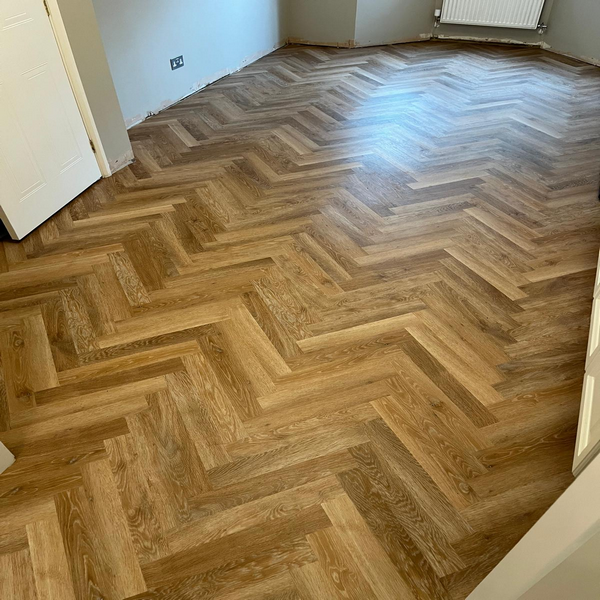
5. Stone Plastic Composite (SPC)
SPC represents the cutting edge of vinyl flooring technology. This innovative product combines limestone (calcium carbonate) with PVC and stabilisers, creating an extraordinarily dense, rigid core that’s built to last.
The limestone-based mixture gives SPC remarkable stability and durability – we’re talking potential lifespans of 20-30 years. The rigid construction provides excellent resistance to dents, temperature fluctuations, and water damage that would trouble other flooring types.
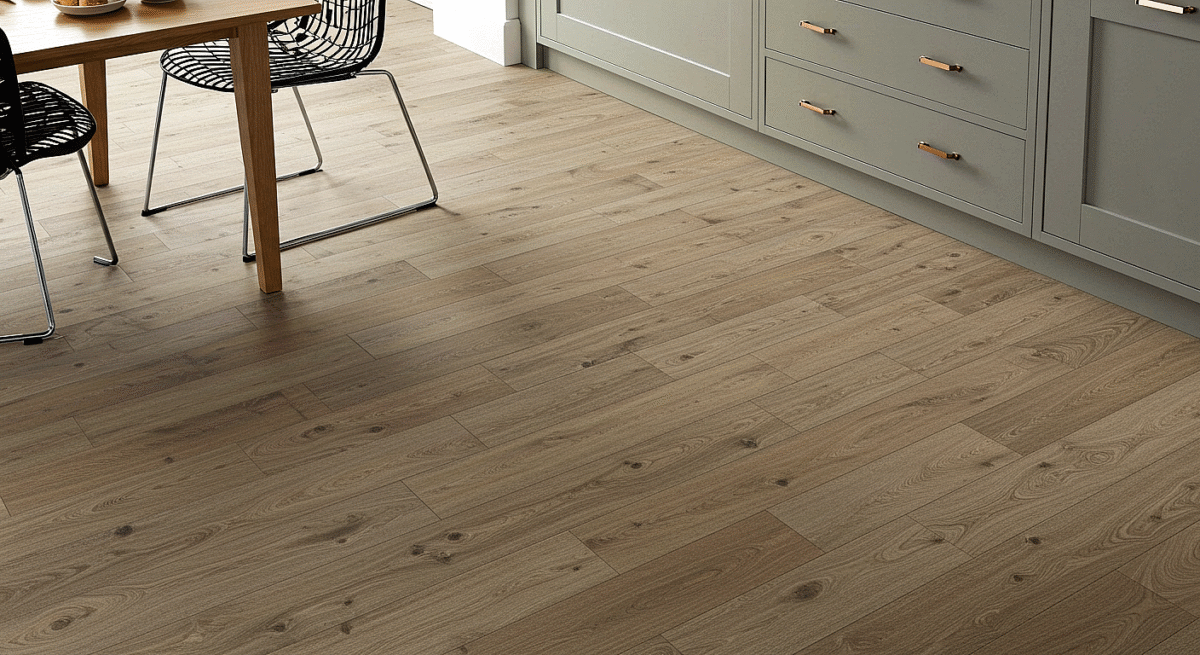
SPC features layered construction including wear layer, design layer, the stone composite core, and sometimes attached underlayment for added comfort and sound reduction. With prices typically ranging from £2.78 to £5.56 per square foot, SPC offers exceptional value considering its impressive performance characteristics.
6. Wood Plastic Composite (WPC)
WPC combines wood fibres with thermoplastic polymers, creating a slightly softer feel than SPC whilst maintaining excellent durability. This 100% waterproof engineered luxury vinyl provides impressive noise reduction and comfort underfoot – particularly valuable for busy family homes.
The multiple inner layers provide stability, warmth, and acoustic benefits that make WPC particularly suitable for residential applications. The built-in underlay eliminates the need for additional cushioning materials during installation, streamlining the process.
Despite being rigid enough for click-lock installation systems, WPC offers more resilience than pure stone composites, creating a comfortable walking surface. This makes it an excellent choice for areas where you’ll be standing for extended periods, such as kitchens where meal preparation keeps you on your feet.
Vinyl Flooring by Installation Method
Choosing your vinyl style is just the beginning – the installation method you pick can make all the difference to your floor’s performance and longevity. Each approach has its own advantages, so let’s explore which one suits your project best.
Click-Lock Vinyl
Click-lock vinyl flooring uses a clever interlocking system that lets planks snap together without any messy adhesives. This floating installation has become a favourite for DIY enthusiasts, and it’s easy to see why. The planks feature specially designed edges – a tongue on one side and groove on the other – creating a secure connection when properly aligned.
Your installation should begin parallel to the room’s longest wall, ideally following the light from windows and doors. You’ll need surprisingly few tools: just a utility knife and straight edge for cutting. No saw required! Remember to maintain a 5/16″ (8.2mm) expansion gap around the perimeter – your floor needs room to breathe with humidity changes.
The beauty of click-lock vinyl lies in its straightforward installation. Without glue, nails, or staples, the job moves quickly and costs less even with professional fitting. Better still, click-lock systems forgive minor subfloor imperfections and often install right over existing flooring, provided it’s clean and level.
Takeaway Tip: Always leave expansion gaps around the perimeter – you’ll cover these with skirting boards or moulding anyway.
Glue-Down Vinyl
Glue-down installation creates a permanent bond between each plank and your subfloor using specialist adhesive. This method excels in high-traffic areas and commercial spaces where stability matters most. You’ll find two main adhesive types: hard set (similar to carpet adhesive) and pressure sensitive (easier to replace later).
The direct bond delivers exceptional stability – no shifting even under heavy furniture or appliances. Your floor will feel solid underfoot and create a quieter walking surface compared to floating alternatives. Since planks stay fixed in place, you typically won’t need expansion gaps around the edges.
However, glue-down demands more intensive preparation. Your subfloor must be absolutely perfect – any bumps or dips will show through the finished floor. The adhesive application requires skill and precision, often meaning professional installation and higher labour costs.
Loose Lay Vinyl
Loose lay offers perhaps the most straightforward approach, relying on the product’s weight and friction to stay put. Modern loose lay vinyl features heavy fibreglass backing that naturally lies flat without adhesive across most of the floor.
For homes, a minimal adhesive approach works brilliantly. Simply place double-sided tape around the room’s edges and in a grid pattern throughout larger spaces. Commercial settings with heavier traffic might need full adhesive coverage.
This method shines when you need occasional subfloor access or prefer temporary installation. You can roll up and relocate loose lay vinyl if needed – perfect for situations where appliances might overflow or need maintenance.
Self-Adhesive Vinyl
Self-adhesive vinyl tiles come with pre-applied backing, eliminating separate adhesive application. DIY enthusiasts love these peel-and-stick options for their simple installation process.
Success depends entirely on subfloor preparation – it must be spotlessly clean, bone dry, and perfectly smooth. Even tiny particles create visible bumps in your finished floor. Temperature matters too: keep your room between 18-29°C during and after installation for proper adhesion.
Keep things on track:
- Start from the room’s centre and work outward
- Remove backing from one tile at a time
- Press firmly and continue in a step pattern
- Roll the entire floor afterwards to secure the bond
Self-adhesive vinyl delivers quick installation with minimal mess, but proper subfloor prep remains absolutely crucial. These work particularly well in smaller spaces like bathrooms and utility rooms where you want minimal disruption.
Room-by-Room Guide to Choosing Vinyl Flooring
Choosing the right vinyl flooring for each space means matching the practical demands of daily life with your personal style preferences. Every room presents its own challenges, and certain vinyl types handle these better than others. Here’s your room-by-room breakdown to help you make the best choice for every corner of your home.
Kitchen
Your kitchen needs flooring that can handle whatever you throw at it – literally. Spills, splashes, and constant foot traffic are just part of kitchen life. Stone Plastic Composite (SPC) is your best friend here, offering completely waterproof construction that won’t budge under pressure. Look for vinyl with a thick wear layer of at least 20 mil to stand up to daily kitchen chaos.
Smart colour choices make a real difference in kitchens. Medium to dark tones cleverly hide those inevitable food stains and everyday dirt. Luxury Vinyl Tile (LVT) gives you the best of both worlds – serious practical performance plus style options that’ll complement any kitchen design. The comfort factor is brilliant too – your feet will thank you during those long cooking sessions, especially compared to cold ceramic or stone.
Bathroom
Moisture resistance becomes absolutely critical in bathrooms. Both luxury vinyl flooring (LVT) and vinyl work beautifully here thanks to their excellent waterproofing. Unlike laminate or hardwood, quality vinyl simply won’t warp or deteriorate when faced with persistent bathroom moisture.

The easy maintenance is a game-changer for busy bathrooms – just wipe up spills with a damp cloth and you’re done. Smaller bathrooms particularly benefit from sheet vinyl, which minimises seams where water might sneak through. Plus, vinyl feels wonderfully warm underfoot during those chilly morning routines – a welcome change from cold ceramic tiles.
Living Room
Comfort and style take centre stage in your living room. Vinyl’s excellent thermal properties create that warm, inviting atmosphere you’re after. Since this is where your heaviest furniture lives, vinyl’s resistance to scratches, stains, and dents makes it a sensible choice.
The design possibilities are endless – from wood effects that suit traditional spaces to contemporary patterns for modern homes. Luxury Vinyl Tile in wood-effect designs creates a sophisticated yet practical living room floor. The sound-absorbing qualities help maintain that peaceful atmosphere you want for relaxing and entertaining.
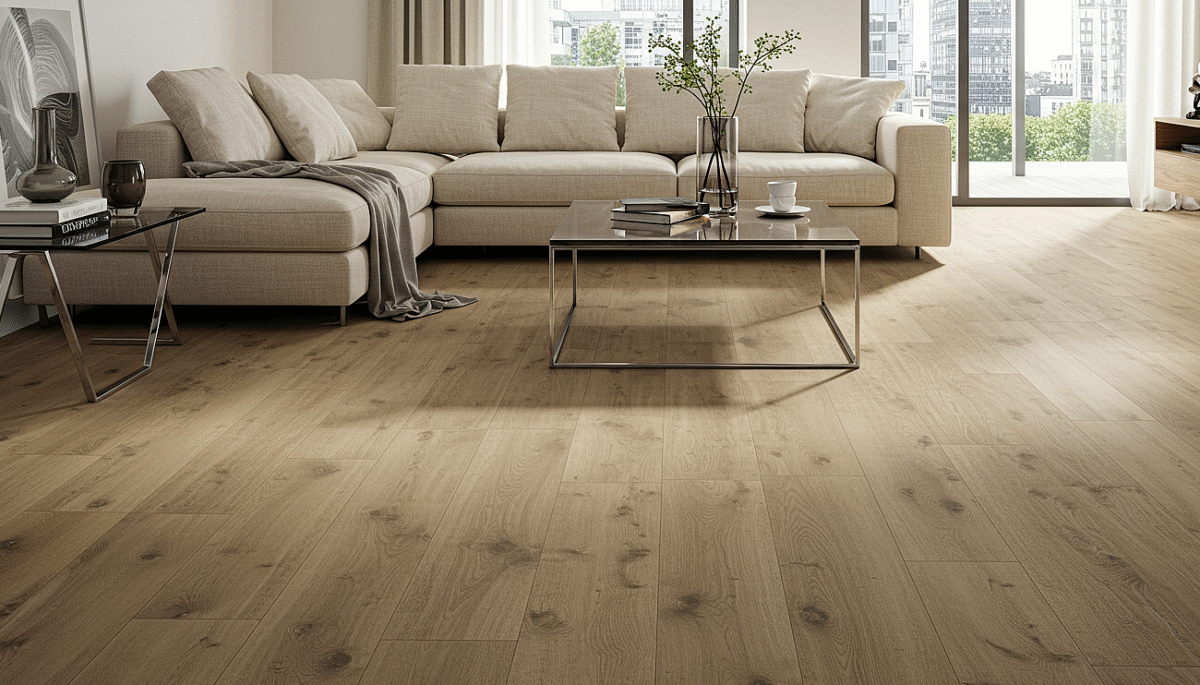
Bedroom
Your bedroom deserves the comfort that vinyl delivers so well. The cushioned feel is particularly lovely for bare feet. Vinyl’s sound-absorbing properties help create the peaceful environment essential for good sleep.
Installation ease is another bedroom bonus – most vinyl floors can be fitted in just one day, minimising disruption to your rest space. Choose from tranquil, soft tones for a calming retreat or bolder patterns if that’s more your style.
Hallway and Stairs
These high-traffic zones need flooring that can take a beating and still look good. Luxury vinyl tiles with rigid cores offer superior resilience against scratches, scuffs, and dents – exactly what you need in these busy areas.
Water resistance matters here too, especially in entrance hallways where wet shoes are a daily occurrence. Create a cohesive look by extending your hallway vinyl up the stairs and into upper areas. Darker colours and wood-effect patterns in herringbone designs add visual interest while cleverly hiding the daily dirt these areas attract.
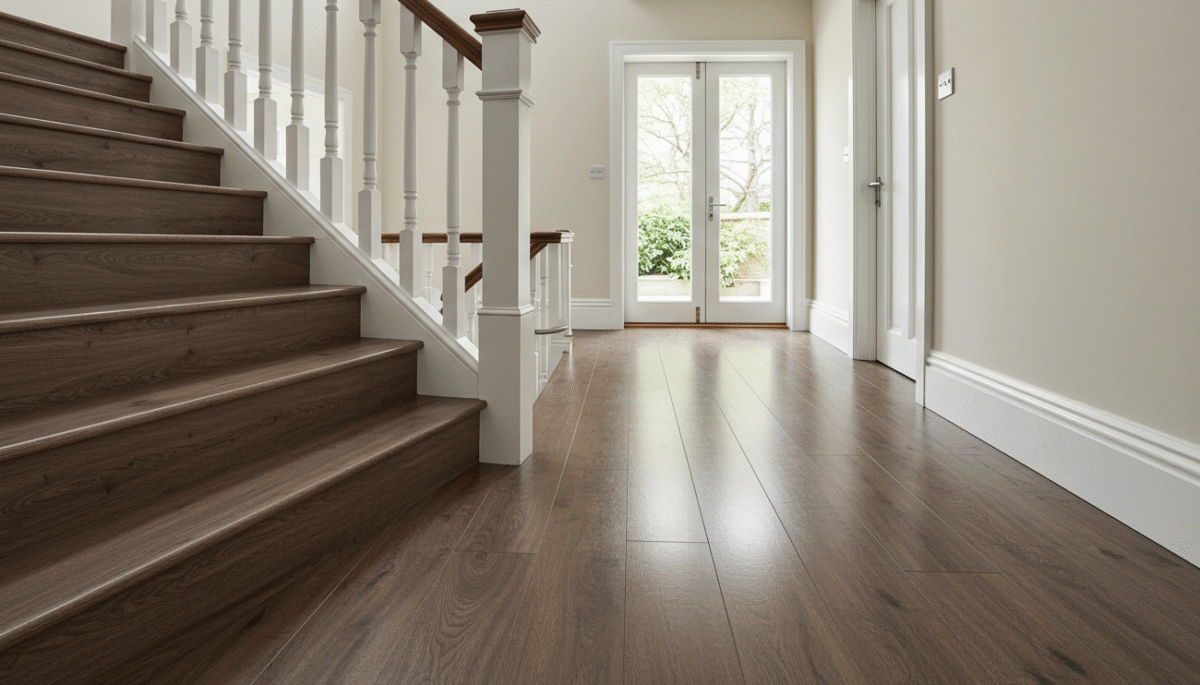
Consider how thickness, wear layer, and installation method will work best for each room’s specific needs and your overall design vision.
Key Features to Look for in Vinyl Flooring
What should you prioritise when choosing vinyl flooring? Beyond the obvious appeal of colour and pattern, these four performance features will make the real difference in how your floor performs day after day.
Waterproofing
Here’s where vinyl truly shines. While all vinyl is water-resistant, many Luxury Vinyl Tile (LVT) brands offer 100% waterproof protection. This makes vinyl absolutely perfect for bathrooms, kitchens, and utility rooms where spills are part of daily life.
But here’s the thing – proper installation is crucial for getting the full waterproof benefits. For bathrooms, you’ll want to seal those edges thoroughly to prevent water from sneaking underneath. If you’re dealing with frequent moisture exposure, Stone Plastic Composite (SPC) cores give you superior waterproof performance compared to standard PVC cores.
Scratch Resistance
Your vinyl’s durability comes down to one key component – the wear layer. This transparent protective coating shields your beautiful design layer from daily life. The thickness ranges from 0.1mm to 0.7mm, and choosing the right thickness matters more than you might think.
Here’s your wear layer guide:
- 0.1mm-0.2mm: Perfect for low-traffic areas like guest bedrooms
- 0.3mm-0.5mm: Ideal for general household use including kitchens and living areas
- 0.5mm-0.7mm: Essential for high-traffic zones or homes with pets and children
Remember, no vinyl is completely scratchproof, but you can protect your investment. Door mats, furniture protectors, and soft-wheel castor chairs will keep your floor looking fresh for years.
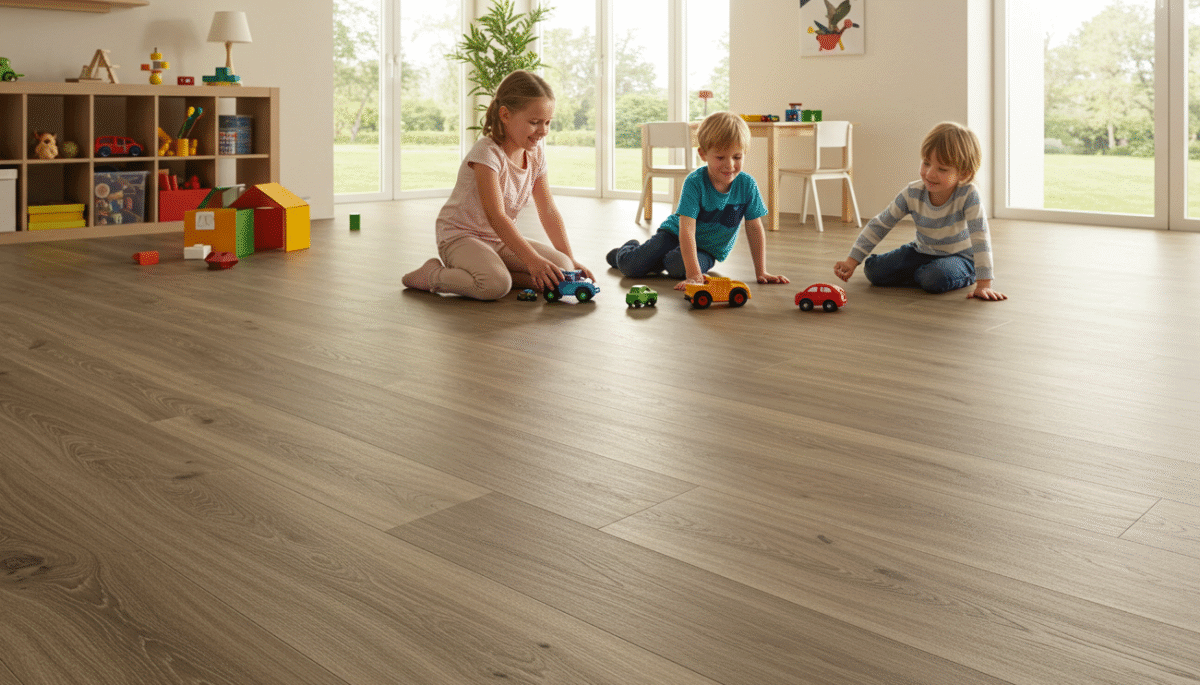
Sound Absorption
Worried about noise? Vinyl flooring with built-in underlay effectively reduces sound transmission between floors and minimises that annoying walking noise. Premium acoustic vinyl products can reduce impact sound by at least 18dB – that’s a significant difference you’ll actually notice.
The thickness of your flooring plays a huge role here. Thicker options with foam backing or cushioned layers provide superior sound absorption. For maximum acoustic benefits, look for specialised products like iQ Acoustic, which offers -16dB impact sound reduction without compromising durability.
Underfoot Comfort
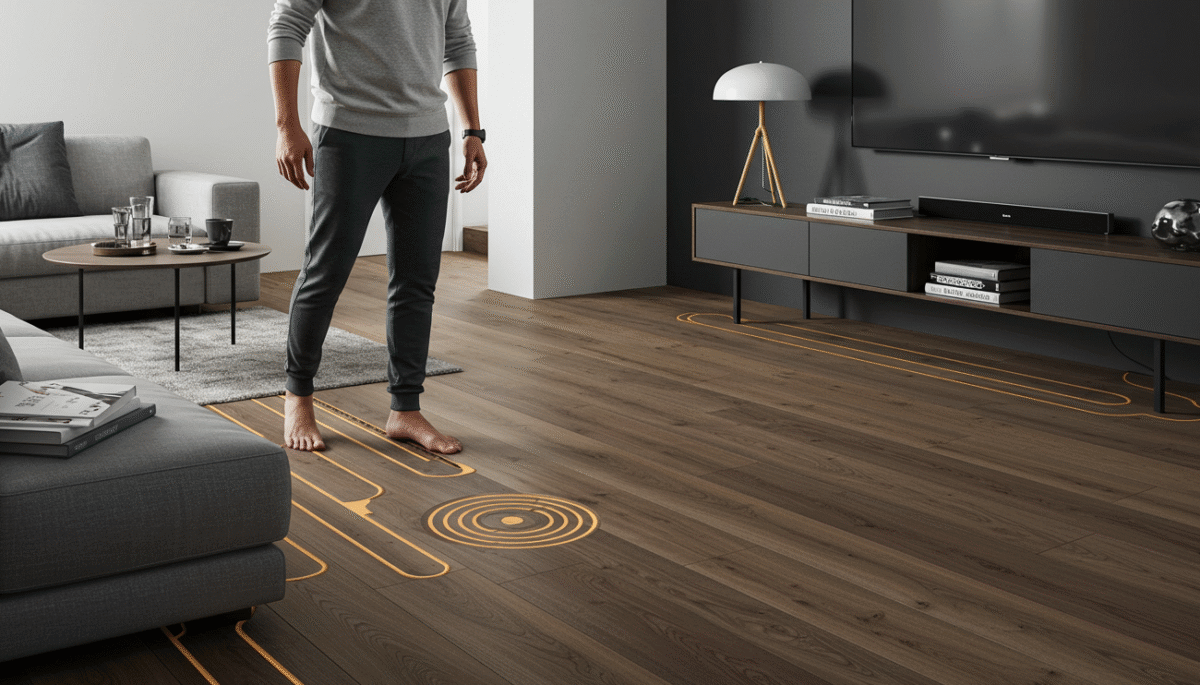
One of vinyl’s most beloved qualities is simply how good it feels underfoot. It’s softer and warmer than ceramic tiles or laminate flooring, creating a much more welcoming surface for bare feet.
Different types offer varying comfort levels. Sheet vinyl typically features foam or felt backing for enhanced softness, while Wood Plastic Composite (WPC) provides more resilience than pure stone composites – especially comfortable for areas where you’ll stand for extended periods.
Want even more comfort? Cushioned vinyl flooring incorporates a foam layer that feels pleasant underfoot whilst adding warmth to your room. Plus, vinyl’s compatibility with underfloor heating systems enhances comfort during colder months, creating that cosy atmosphere you’ll love coming home to.
Vinyl Flooring Styles and Finishes
The visual possibilities with vinyl flooring are simply endless. Today’s manufacturing techniques have created stunning options that cater to every design preference you can imagine. Whether you’re drawn to traditional charm or contemporary edge, the right finish can completely transform your space while delivering all those practical benefits we love about vinyl.
Wood Effect
Wood effect luxury vinyl flooring captures all the beauty and warmth of natural timber without any of those pesky maintenance headaches. Modern vinyl planks feature expertly crafted surfaces with textured layers that include realistic knot details – the result is so convincing, your guests might do a double-take.
These planks come in gorgeous wooden tones, from light oak that brightens any room to rich contemporary walnut that adds instant sophistication. The best part? You get all the practical advantages over real timber – complete waterproofing, better slip resistance, and perfect compatibility with underfloor heating systems.
Stone Effect
Stone effect vinyl tiles bring the timeless elegance of luxury natural stone into your home through incredibly realistic textures and colours. This category includes beautiful replications of marble, slate, travertine, and other high-end stone finishes that would normally cost a fortune.
You get all that sophisticated stone-look appeal without the coldness underfoot or the endless maintenance that genuine stone demands. High-quality stone effect vinyl maintains its visual impact while standing up to daily life, making it perfect for creating elegant spaces that actually work for busy households.
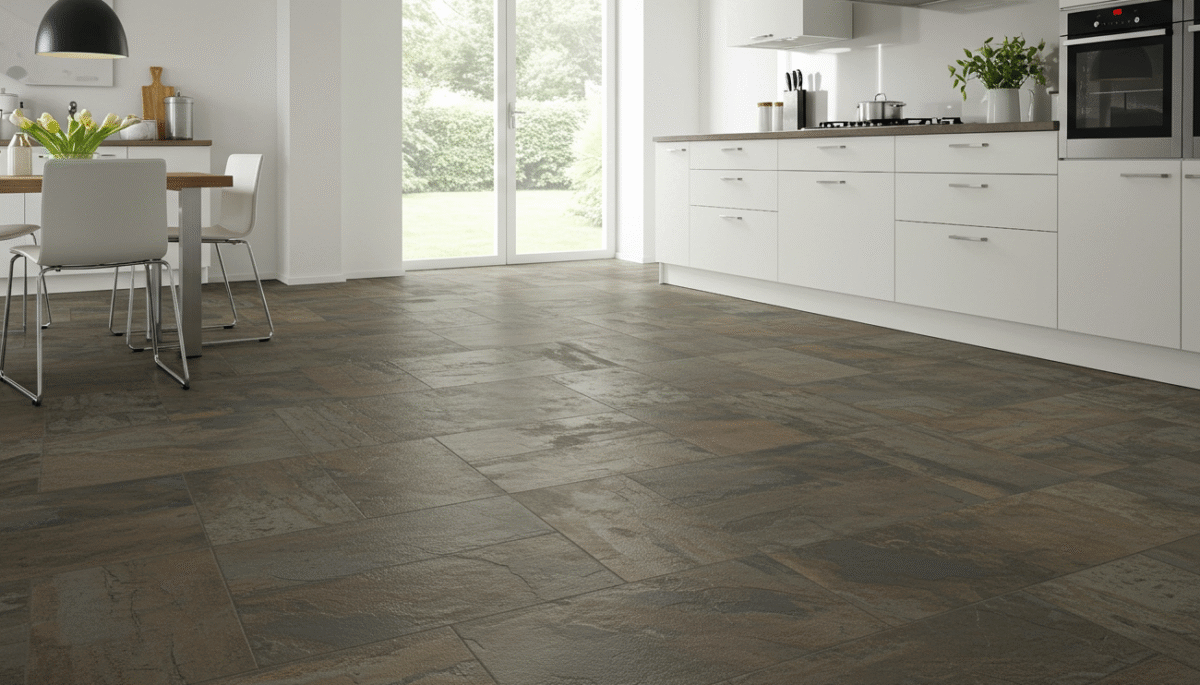
Patterned and Funky Designs
Want to make a real statement? Patterned vinyl flooring brings personality and character to any room. The options are fantastic:
- Geometric designs that blend traditional and contemporary styles beautifully
- Retro patterns offering vibrant, hip styling in striking monochrome or bold colours
- Chequered layouts providing timeless appeal in classic black and white or exciting colour combinations
- Lattice patterns creating sophisticated ceramic-like appearances
These funky designs work like feature walls for your floor – they draw the eye and create amazing focal points. Plus, patterned vinyl is brilliant at hiding signs of wear and tear better than plain options.
Plain and Minimalist Options
Sometimes simplicity is exactly what your space needs. Plain vinyl flooring creates a clean, versatile canvas that lets your furniture and artwork take centre stage. This understated elegance works particularly well when you want other design elements to command attention.
Available in countless solid colours, plain vinyl offers timeless appeal that won’t date as trends change. The uninterrupted surface adds sophistication while maintaining all the durability vinyl is famous for. And maintenance? Just a quick sweep or mop keeps these floors looking pristine.
Do You Need Underlay for Vinyl Flooring?
Here’s a question that confuses many homeowners: do you actually need underlay with your vinyl flooring? The answer might surprise you. Unlike other flooring types, vinyl doesn’t follow the usual rules, and understanding when underlay is essential—and when it’s completely unnecessary—can save you both money and installation headaches.
When Underlay is Required
Here’s something that catches most people off guard: sheet vinyl (sometimes called lino) typically doesn’t need underlay at all. Provided your surface is smooth, clean and level, modern sheet vinyl performs brilliantly without any additional layers underneath.
Why does this work so well? There are three key reasons. First, today’s vinyl sheets already come with a built-in cushioned base layer that provides plenty of thermal and sound insulation. Second, vinyl’s natural durability means it can handle daily wear without needing extra protection. And third, it’s specifically engineered for direct installation onto both concrete and wooden subfloors.
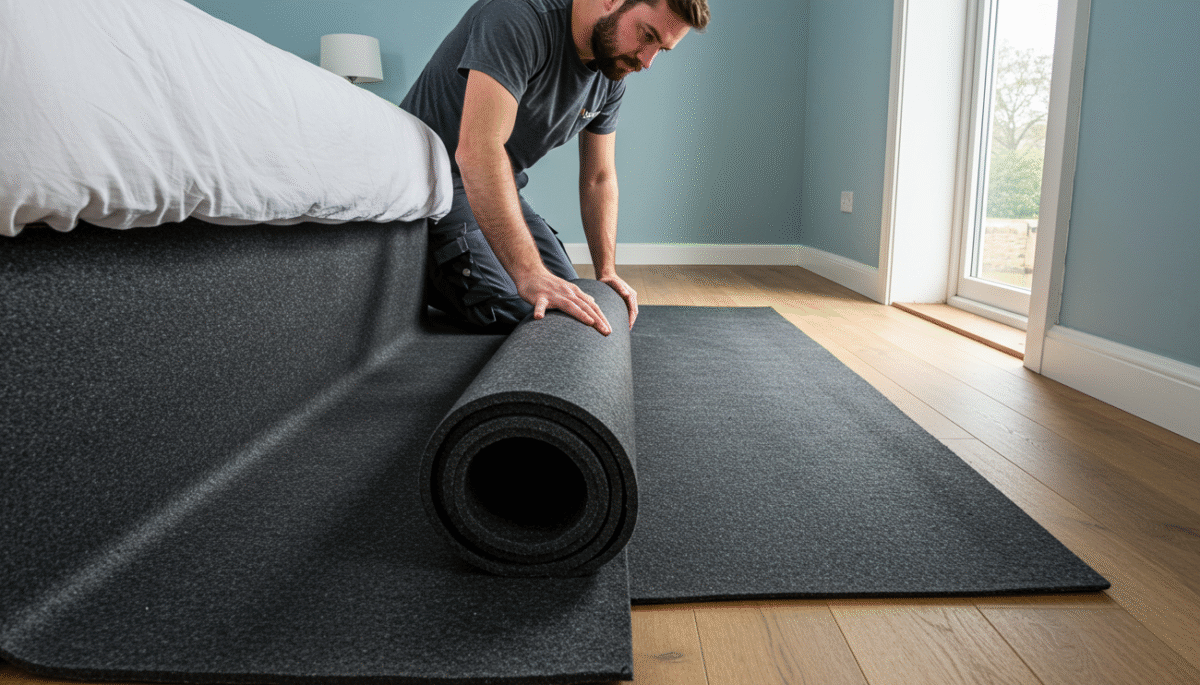
However, click-system luxury vinyl tiles (LVT) are a different story entirely. These floating floors usually benefit enormously from underlay because it prevents unwanted movement, creates a moisture barrier, and boosts both insulation and sound absorption.
Types of Underlay for Vinyl
When you do need underlay for vinyl flooring, thickness matters more than you might think. You’ll want something much thinner than what you’d use for laminate or hardwood—typically between 1mm and 1.5mm thick. Use anything thicker and you risk damaging the locking mechanisms of your vinyl planks.
You’ve got three main options to choose from:
- Standard LVT vinyl click underlay (high-density foam with silver foil backing)
- Acoustic vinyl click underlay (reducing impact noise by up to 19dB)
- Specialised thermo pro X underfloor heating underlay (maximising heat transfer efficiency)
The pricing stays competitive too, ranging from £3.25 to £3.70 per m² as of May 2024.
Built-in Underlay Options
Manufacturers have made life easier in recent years by introducing luxury vinyl tiles with pre-applied underlay. These clever integrated solutions boost comfort underfoot while reducing noise transmission at the same time. The best part? You eliminate separate purchases and installation steps entirely.
For busy households, these products deliver water resistance and scratch protection alongside all the practical benefits of built-in cushioning. That’s exactly why they’ve become so popular with homeowners who want straightforward yet high-performance flooring solutions.
Maintenance and Cleaning Tips
Keeping your vinyl flooring looking beautiful doesn’t have to be complicated. Whether you’ve chosen luxury vinyl tiles or sheet vinyl, these straightforward cleaning routines will help preserve their appearance and extend their lifespan significantly.
Daily Cleaning
Your vinyl floor’s biggest enemy? Those tiny particles of dirt and debris that act like sandpaper on the surface. Sweep daily using a soft-bristled broom to remove this grit before it can cause damage. For a more thorough clean, vacuum using a hard floor setting – just make sure there’s no beater bar attachment that could scratch your protective wear layer.
Here’s a simple trick that makes a huge difference: place high-quality doormats at all entrances. These trap up to 80% of dirt before it reaches your vinyl floors, dramatically reducing both cleaning frequency and potential damage.
Dealing with Spills
Speed matters when spills happen on vinyl flooring. Blot liquids immediately with a clean, absorbent cloth rather than letting them sit – standing moisture can potentially weaken the adhesives underneath your floor.
For everyday food stains, a mixture of mild soap and warm water works perfectly. Alternatively, try a diluted solution of one part vinegar to three parts water for stubborn marks.
Different stains need different approaches:
- Ink or makeup: Gently dab with isopropyl alcohol on a soft cloth
- Scuff marks: A pencil eraser often removes these effectively
- Stubborn residue: Always check manufacturer recommendations before using stronger solvents
Long-Term Care
Establish a simple cleaning schedule that works: sweep daily, damp mop weekly, and deep clean every 1-2 months. When mopping, remember that vinyl is water-resistant but not completely waterproof – excessive water might seep into seams and cause problems.
Protect your investment with felt pads under furniture legs to prevent scratches and dents. If your room gets lots of direct sunlight, consider using blinds or curtains to prevent fading over time.
One important note: vinyl flooring doesn’t need waxing or polishing. These products can actually damage the protective layer and leave unwanted residue. Stick to consistent basic care, and your floor will maintain its original appearance throughout its impressive lifespan.
Conclusion
Vinyl flooring really is a smart choice for modern homes. You’ve now got all the knowledge you need to choose confidently between the six main types, understand which installation method suits your situation, and know exactly what to look for in each room.
Remember, there’s no single “perfect” vinyl flooring – just the perfect one for your specific needs. Whether you’re drawn to the realistic wood effects for your living room or need the tough durability of SPC for your kitchen, you can rest easy knowing you’re making a practical investment.
Your vinyl floors will reward you with years of beautiful, low-maintenance performance. So go ahead – choose the style that makes you smile every time you walk through your door.